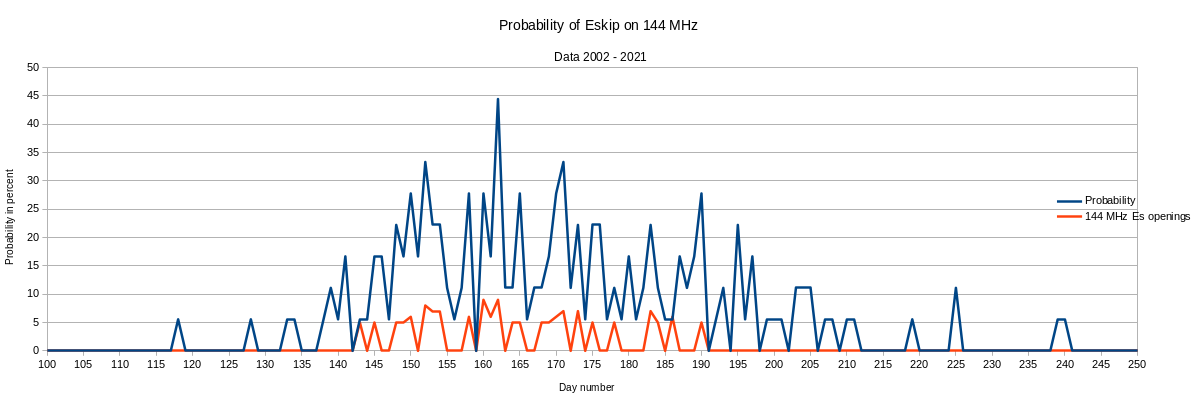High MUF on VHF
(2021-05-26) PE1ITR
Regularly the question arises whether there is a regularity is the sporadic E layer openings on VHF, which makes distant QSO's at 144 MHz possible. There are several theories about this that see a connection in Meteor showers, Jet streams etc .. There is a lot of information about this, but that's not what this webpage is about.
Apart from scientific approaches, there seem to be days in which there is more Es than other days. We can write those days in the agenda to pay extra attention. Or take time off from work ...
High MUF
Below a graph in which the MUF around my location is plotted against the day and year to see a pattern. DXspot data over the last 21 years has been used. Clear is a chaotic pattern.
However, on average over several years there are days when there has been clearly more Es than other days. The red dots represent a high MUF in which 144 MHz is possible.
In the second graph, the days with an average high stale are seen more clearly. The red also shows actual openings at 2m.

MUF 1200 km around my QTH (JO21QK). Daynr 100 is around 10 april and Daynr 250 is around 7 september. The red dots represent a high MUF.

MUF 1200 km around my QTH (JO21QK). Daynr 100 is around 10 april and Daynr 250 is around 7 september. The red line also shows actual openings at 2m
Agenda
When the red points are counted over the years in the graph, you arrive at the following days on which there are clearly more red points than others. Based on my personal experience, I often see E-skip openings during or just after an increased meteor activity.
127,129: 6 - 9 may: coincides with η - Aquariids May 06 and η - Lyrids May 08
137: 17 may: coincides with May Arietids 19 may (Daytime shower)
140: 21 - 27 may: coincides with o - Cetids May 20 (Daytime shower)
150: peak 29/30 may
152, 153, 154: 31 may - 3 june. Peak on 31 may/1 june:
158, 160: 6/7, 9 june: Daytime Arietids June 7, Zeta-Perseids (172 ZPE) June 9
162: peak 10/11 june: Also possibly connected to daytime Zeta-Perseids (172 ZPE)
165: peak 13/14 june: The Zeta Perseids (ζ–Perseids) are a daylight meteor shower that takes place from about May 20 to July 5. Date of peak 9 - 13 june.
170 - 173: 18 - 22 june: peak on 170 and 171.
183: 2 - 3 july: (Maybe connected to B-Taurids?)
187: 6 july:
190: 8/9 july:
Es propagation on higher VHF bands is a complex mechanism. It seems to me that the Arietids and the Zeta-Perseids Daytime meteorshowers are playing an important role in our 2m Es season.
In conclusion, it is best to take time off from work in the period 29 - 14 June and then wait behind the transceiver for an Sporadic E-skip opening on 144 MHz. Most likely something will happen during that period.
HOME | Go Back

